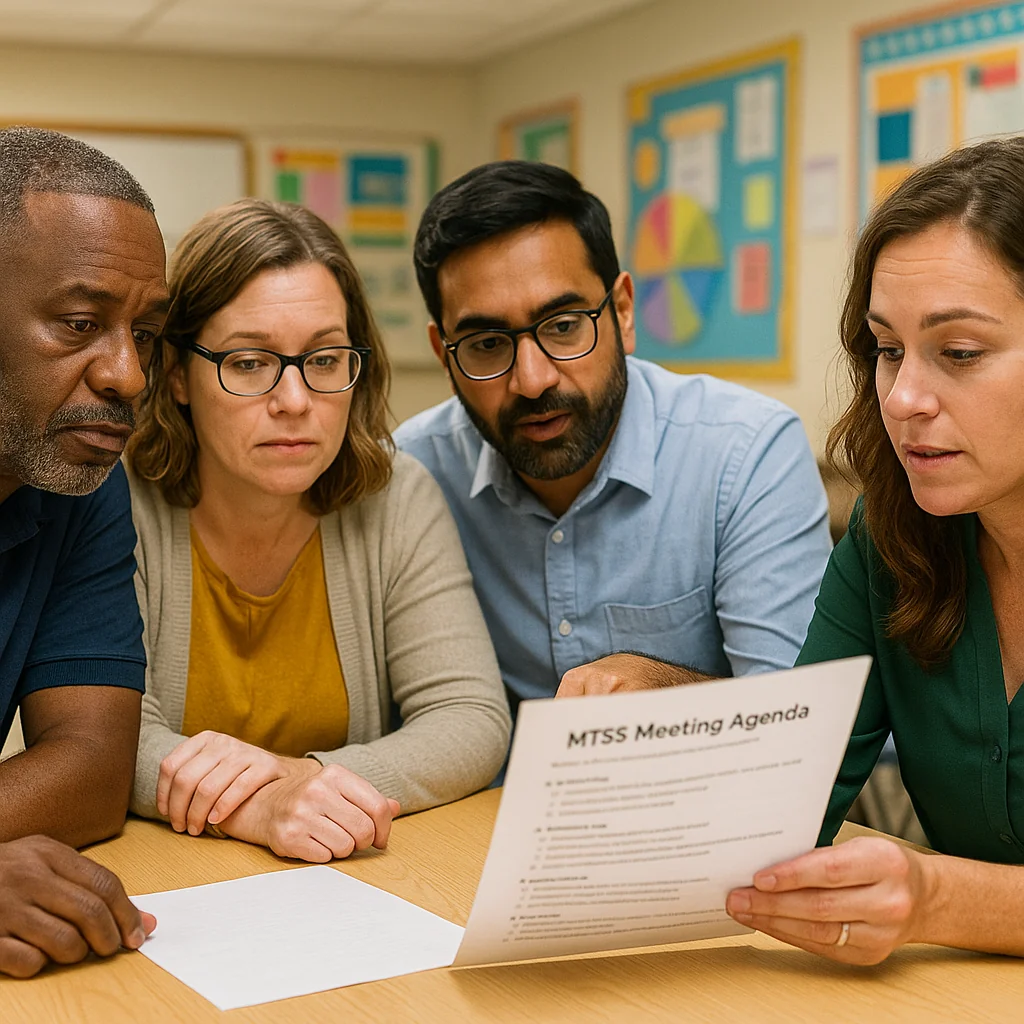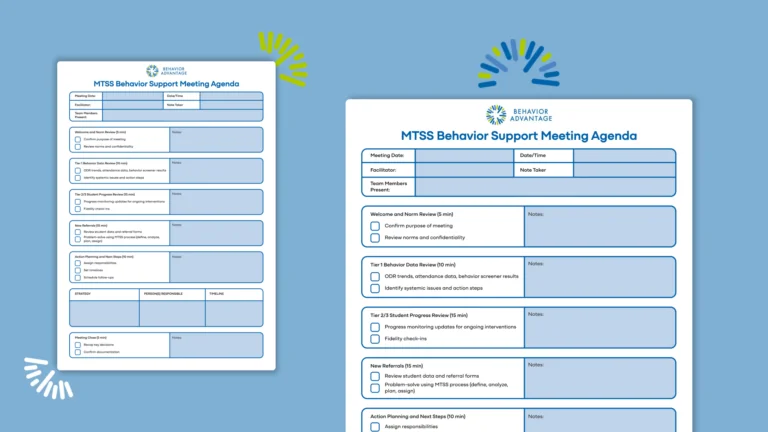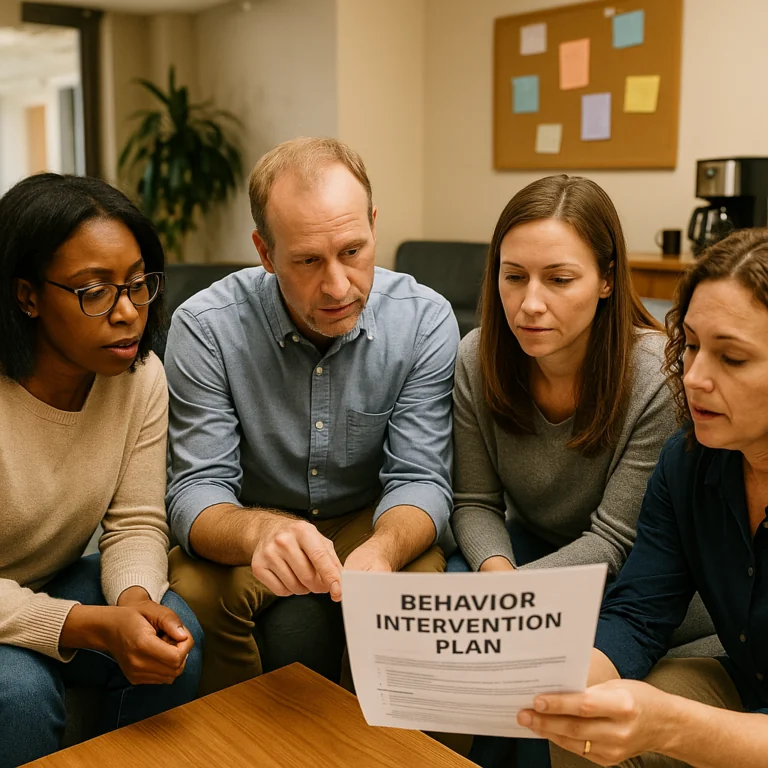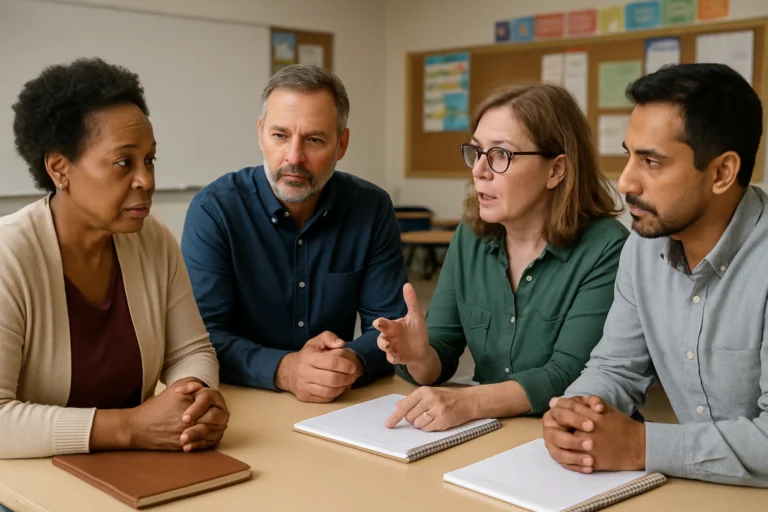For educators and support teams working in Multi-Tiered Systems of Support (MTSS), meetings are the heart of collaboration. They’re where big ideas meet real student needs. But too often, MTSS meetings feel unproductive, unclear, or reactive – especially when addressing behavior.
If you’re an administrator, teacher, school psychologist, counselor, MTSS coordinator, or other team member, this guide will help you run effective MTSS meetings. The next paragraphs will discuss how to sharpen the structure and purpose of your MTSS meetings, with a clear focus on behavior support and data-driven decisions.
Download Our MTSS Behavior Support Meeting Agenda to Get Started
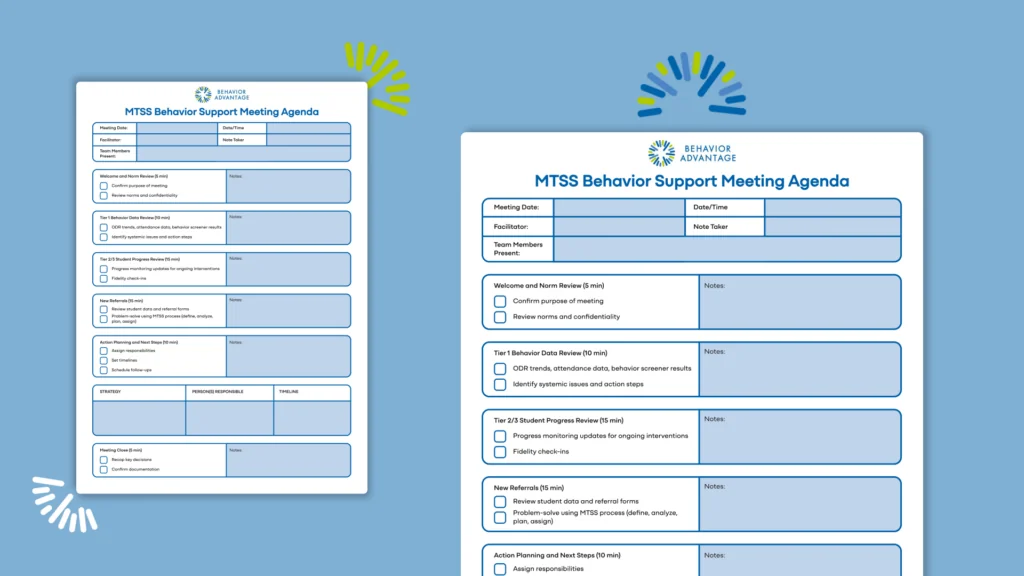
What Is an MTSS Meeting?
An MTSS meeting is a structured, collaborative session where school-based teams review data, problem-solve, and allocate tiered interventions to support student academic, behavioral, and social-emotional needs. These meetings occur regularly (e.g., biweekly) and are central to ensuring that interventions are responsive, equitable, and effective.
Typically, MTSS meetings are used to:
- Examine school-wide Tier 1 systems to ensure consistent and inclusive practices
- Identify students who require additional support through screening or referrals
- Develop, implement, and monitor Tier 2 and Tier 3 interventions
- Review student progress and adjust supports based on data
The specific scope of each MTSS meeting may vary depending on school needs. Some meetings focus on systems-level decisions (e.g., analyzing trends in behavior data, evaluating universal supports), while others are devoted to individual student problem-solving. Clarifying the focus ahead of time helps teams allocate time effectively and stay purpose-driven.
Who Attends MTSS Meetings?
The composition of your MTSS committee should reflect a multi-disciplinary approach. Each member should understand MTSS principles and be able to contribute to both problem-solving and follow-up. Below we share examples of the specific staff and roles that should be considered to Build the Right Team.
What Makes MTSS Meetings Effective?
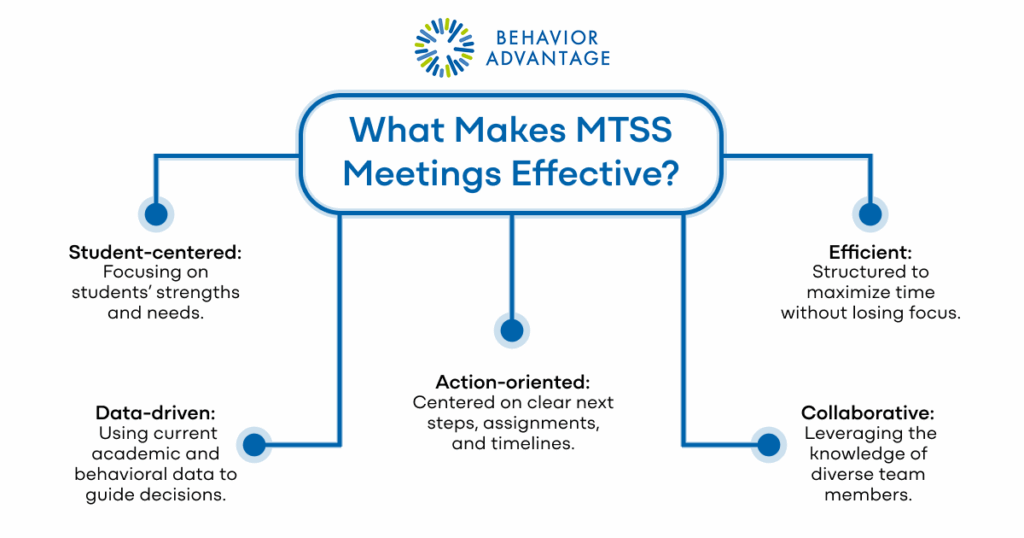
Let’s break down the key components into 10 Steps for Running Effective MTSS Meetings:
1. Clarify Your MTSS Team’s Purpose and Scope
Effective MTSS meetings are intentional. Begin by defining the primary objectives of your team and the scope of each meeting. Are you:
- Reviewing universal (Tier 1) behavior systems?
- Analyzing progress and planning supports for Tier 2 or Tier 3 students?
- Monitoring fidelity and outcomes of implemented interventions?
- Identifying systemic trends and areas of disproportionality?
Distinguishing between systems-level meetings (e.g., Tier 1 reviews and professional learning planning) and student-level problem-solving meetings (Tier 2/3) helps ensure clarity of focus and use of time. Consider scheduling separate meetings for each if needed.
2. Build the Right Team
An effective MTSS team includes diverse voices and perspectives. Team members should know their role and have access to the information and authority they need to take action. Ideally, your team includes:
- Administrator – for leadership, resource allocation, and authority
- General education and special education teachers – to provide classroom perspectives
- School psychologist or counselor – for expertise in behavioral and mental health supports
- Behavior interventionist or PBIS coach – to support intervention planning and monitoring
- MTSS coordinator or instructional lead – to guide process alignment
- Equity, EL, or family engagement specialist – to ensure culturally responsive practices
3. Use a Consistent MTSS Meeting Agenda
Structure is key to running effective MTSS meetings. A consistent agenda keeps the team focused, maximizes time, and ensures follow-through. Each meeting should follow a clear sequence—starting with norms and purpose, reviewing Tier 1 behavior data, monitoring Tier 2/3 student progress, addressing new referrals through team-based problem-solving, and ending with action steps and follow-ups. Using a shared platform to document decisions helps maintain accountability across meetings. Below is a downloadable, behavior-focused MTSS Meeting Agenda Template you can adapt for your school.
4. Anchor Conversations in Data
Effective MTSS meetings don’t rely on hunches or anecdotes—they’re grounded in data. The key is to bring the right data to the table and use it wisely. For behavior-focused meetings focused on Tier 1, consider bringing:
- Office Discipline Referral (ODR) summaries, by time, location, and type of incident
- Attendance and tardy trends
- Universal screener results (e.g., SRSS-IE, SAEBRS)
For regularly occurring MTSS meetings evaluating behavior supports at the Tier 2 or 3 level, the team will benefit from data such as:
- Progress monitoring data and graphs
- Intervention fidelity checklists
Start each student discussion by asking: What does the data suggest? What are the patterns or concerns? Do interventions need to be changed, continued or faded? Decisions should be grounded in objective information, not anecdotes.
Behavior Advantage can provide teams with automatically graphed behavior data to assist with progress monitoring and decision making! Connect with us to discuss how we can help you and your team run effective MTSS meetings.
5. Follow a Structured Problem-Solving Process
Problem-solving during MTSS meetings should follow a standardized approach. One common model includes:
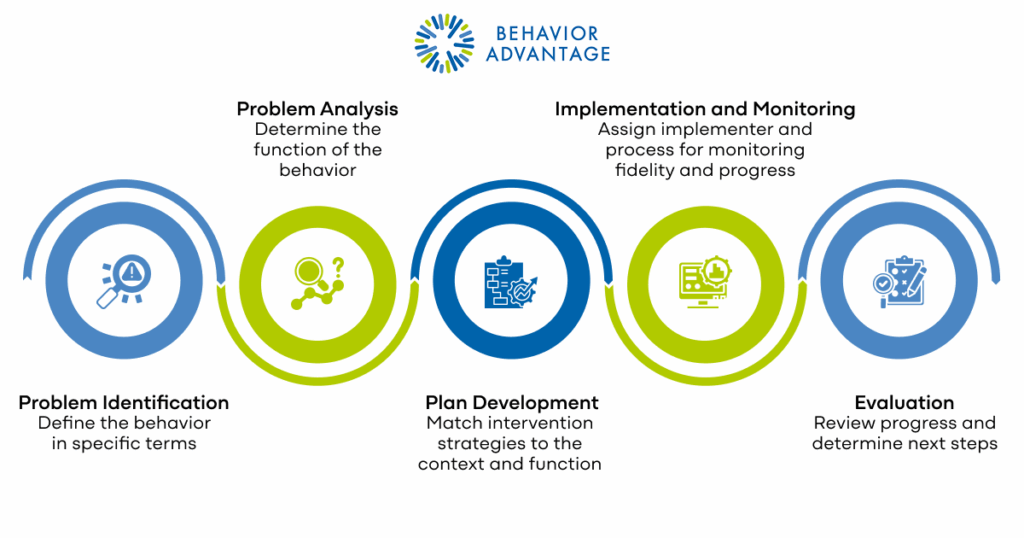
6. Assign Clear Next Steps and Accountability
The most productive MTSS meetings result in action. Be explicit about:
- Who is responsible for each intervention component
- When implementation will begin
- What data will be collected and how
- When the team will reconvene to review progress
The downloadable MTSS Meeting Agenda Template includes a section for documenting action items, persons responsible for implementation and monitoring, and realistic, measurable timelines. Use documented meeting notes, a shared intervention log, or spreadsheet to track this information. Accountability supports fidelity.
7. Make Time for Tier 1
Too often, MTSS meetings become reactive—focusing only on Tier 2 and 3 students. But proactive work at Tier 1 is just as important, as it helps develop a strong foundation to reduce the needs at Tier 2 and beyond.
Use your meetings to review school-wide data and ask:
- Are there grade levels or classrooms with high referral rates?
- Do we need to boost Tier 1 supports like SEL instruction, classroom management, or staff PD?
- Are our universal interventions working for the majority of students?
Based on the needs of your school and the time and resources required at any given time during the school year, consider holding regular meetings for monitoring and improving Tier 1, separate from student intervention team meetings at the Tier 2/3 level.
8. Create a Culture of Collaboration and Trust
The best MTSS teams aren’t just functional—they’re relational. Build a culture where:
- Team members feel heard and respected.
- Concerns are raised constructively, not personally.
- Staff know they won’t be judged for bringing challenging cases.
- Wins (even small ones) are acknowledged and celebrated.
Establishing team norms and regularly revisiting them can help maintain a healthy team culture.
Read our latest blog on Building Effective MTSS Teams for more practical advice on how to manage a successful team.
9. Use Tools to Stay Organized
Consider using simple tools like:
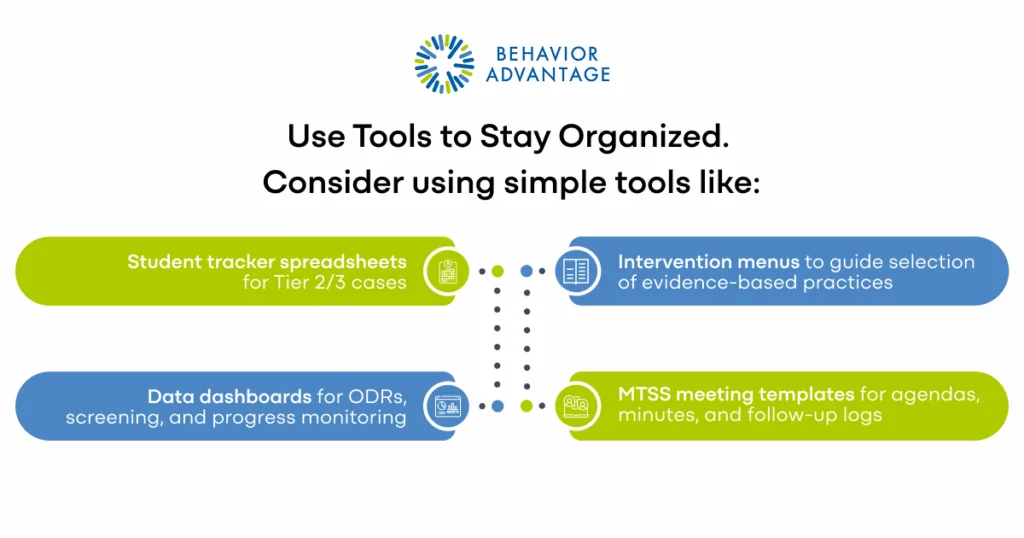
These tools not only keep things moving but also make your MTSS work more visible to school leadership and staff.
10. Reflect and Improve Over Time
At least twice annually, take time to reflect:
- Are we following our MTSS processes consistently?
- Are we seeing improved student outcomes?
- Do team members feel the meetings are effective and meaningful?
- Are we using data to inform decisions?
Continuous improvement is part of the MTSS mindset.
Let’s look at a scenario that illustrates how a middle school MTSS team puts these practices into action to meet key objectives.
Scenario: Applying the MTSS Meeting Process in Practice
At Lincoln Middle School, the MTSS Behavior Support Team meets biweekly to review Tier 2 and Tier 3 cases. During this week’s meeting, the team follows their structured agenda to address both systems-level and individual student needs.
Tier 1 Data Review:
The school counselor presents updated data from the school’s behavior dashboard. Office discipline referrals (ODRs) have increased during unstructured times (lunch/recess), with a notable spike in sixth grade. The team decides to revisit supervision schedules and reinforce expectations through morning announcements and classroom SEL lessons.
Student Case Review – Tier 2:
A sixth-grade student, Mateo, has received five ODRs in the past three weeks for defiance and leaving the classroom without permission. The referring teacher provides a completed Tier 2 referral form and daily behavior tracking sheet.
Problem Identification and Analysis:
- The team defines Mateo’s target behavior: “leaving class without permission during independent work time.”
- A brief functional behavior assessment (FBA) summary suggests the behavior is escape-maintained.
- Data confirms the behavior occurs most often in Language Arts, especially during silent reading.
Intervention Planning:
The team selects Check-In/Check-Out (CICO) with a built-in break pass for Language Arts. The CICO coordinator will meet with Mateo each morning and afternoon. The teacher will offer two pre-scheduled breaks during independent work. Progress will be tracked using a daily report card with a focus on staying in class and asking for breaks appropriately.
Action Steps:
- CICO coordinator will train Mateo on expectations by Friday.
- Teacher will begin intervention Monday and log behavior daily.
- The school psychologist will check fidelity using a brief observation tool next Wednesday.
- Follow-up meeting set for two weeks later.
This scenario illustrates how a behavior-focused MTSS team can use data, a structured problem-solving process, and collaboration to create targeted, proactive support for a student in need.
Final Thoughts
Running effective MTSS meetings doesn’t require perfection, just consistent attention to purpose, process, and people. When done well, these meetings become a powerful lever for student support, equity, and continuous improvement.
Start with small wins—standardize your agenda, tighten your follow-up, or bring stronger data to the table. As your systems get stronger, your capacity to meet students’ needs will grow.
Your MTSS meeting is not just another task on the calendar—it’s a cornerstone of school transformation. Want to improve the way you organize your meetings? Schedule a free demo of Behavior Advantage’s platform to see how our tools can help you with that!


